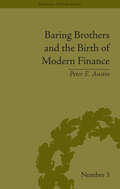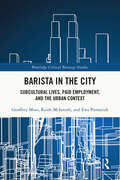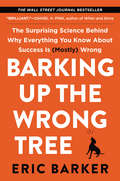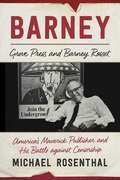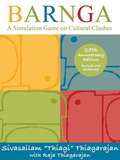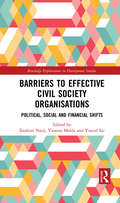- Table View
- List View
Baring Brothers and the Birth of Modern Finance (Financial History #3)
by Peter E AustinIn 1995, the Baring Brothers collapsed over a weekend, brought down by the 'rogue trader' Nick Leeson. Utilizing British and American archives, this work charts Baring Brothers development from wool merchants to one of the most powerful global financial institutions. It also analyses the errors which led to its downfall.
Barista in the City: Subcultural Lives, Paid Employment, and the Urban Context (Routledge Critical Beverage Studies)
by Geoffrey Moss Keith McIntosh Ewa ProtasiukBarista in the City examines the impact of paid employment and the contemporary neoliberal context on the subcultural lives of hipsters who are employed as baristas. This book’s analysis of Philadelphia baristas employed within specialty coffee shops suggests that the existing literature on the relationship between neoliberalism and urban subcultures needs to be amended. The subcultural participants discussed within previous studies lived intensely subcultural lives that were ultimately diminished due to processes of gentrification and displacement. The subcultural lives of the baristas investigated by the authors were greatly diminished from the very beginning. Neoliberal policies, and structures of class, race, gender, and gentrification intersected with their employment in ways that diminished their ability to establish lives that constitute a full-fledged subcultural alternative. In its conclusion, the book presents a new theoretical perspective that could aid researchers who study urban subcultures. It also discusses the implications of its analysis for urban policy. This book is an essential update on previous scholarship pertaining to urban subcultures. It also contributes to existing literatures on hipsters, gentrification, and service sector employment within the city. It is suitable for students and scholars in Urban Sociology, Urban Studies, Cultural Studies, and the Sociology of Work.
Barite-Fluorite Mineralization in Southeast Sichuan, Yangtze Block, China (Modern Approaches in Solid Earth Sciences #23)
by Min Li Hao Zou Shou-Ting Zhang Zhan-Zhang XuThis book describes the mineralization process of barite-fluorite deposits in southeastern Sichuan, Yangtze Block, China. Mainly through systematic field geological surveys and detailed indoor research work, the typical barite-fluorite deposits in this area were analyzed using a variety of analysis methods such as single fluid inclusion LA-ICP-MS composition analysis, trace rare earth element analysis, H-O-S-Sr isotope analysis, F element content analysis, and Sm-Nd geochronological analysis. By in-depth analysis of the ore-forming environment, mineralization process and geological characteristics of barite-fluorite deposits, the following were determined: (1) the source of ore-forming fluids of barite-fluorite deposits and (2) the migration, concentration, enrichment, and evolution of ore-forming sources, exploring the formation mechanism of barite-fluorite deposits. Summarizing the mineralization regularity of the deposit in this area of China provides a new insight and basis for the study of similar types of deposits in the world.
Bark Gift Shop Ltd.
by Susanna Gallani Jan Bouwens Peter KroosThis case describes a setting in which the CFO of Bark Gift Shop Ltd., a gift items retailer, discovers an undesired pattern in the performance data suggesting that her shop managers that perform well during the first part of the year, purposely reduce their effort in the later part of the year. This pattern drives the CFO to reflect on the process by which she sets annual targets for shop managers and how those targets relate to various aspects of their compensation contract. Challenging targets, however, appear to be motivating for a sizeable amount of shop managers. In fact, many shop managers that repeatedly fail to meet the target appear not to be giving up and keep trying to achieve their challenging targets. Therefore, the CFO needs to strike the right balance between providing motivating targets and curbing the undesired behaviors that she just discovered. The case lends itself to a rich discussion of common performance management issues, such as target setting, performance metrics selection, and performance-based compensation design. In particular, the case exposes the students to the issue of target ratcheting. As the case includes a data base it provides ample opportunities for students to practice their analytical skills (producing and discussing descriptive statistics, regressions and interactions).
Barking Up the Wrong Tree: The Surprising Science Behind Why Everything You Know About Success Is (Mostly) Wrong
by Eric BarkerMuch of the advice we’ve been told about achievement is logical, earnest…and downright wrong. In Barking Up the Wrong Tree, Eric Barker reveals the extraordinary science behind what actually determines success and most importantly, how anyone can achieve it. You’ll learn:• Why valedictorians rarely become millionaires, and how your biggest weakness might actually be your greatest strength • Whether nice guys finish last and why the best lessons about cooperation come from gang members, pirates, and serial killers• Why trying to increase confidence fails and how Buddhist philosophy holds a superior solution• The secret ingredient to “grit” that Navy SEALs and disaster survivors leverage to keep going• How to find work-life balance using the strategy of Genghis Khan, the errors of Albert Einstein, and a little lesson from Spider-ManBy looking at what separates the extremely successful from the rest of us, we learn what we can do to be more like them—and find out in some cases why it’s good that we aren’t. Barking Up the Wrong Tree draws on startling statistics and surprising anecdotes to help you understand what works and what doesn’t so you can stop guessing at success and start living the life you want.
Barnes & Noble: Managing the E-Book Revolution
by Alan Maccormack Chris F. Kemerer Brian Kimball DunnCase
Barney: Grove Press and Barney Rosset: America’s Maverick Publisher and His Battle against Censorship
by Michael RosenthalAn incisive, compulsively readable biography of the man the Guardian called the most influential avant-garde publisher of the twentieth century.An impetuous outsider who delighted in confronting American hypocrisy and prudery, Barney Rosset liberated American culture from the constraints of Puritanism. As the head of Grove Press, he single-handedly broke down the laws against obscenity, changing forever the nature of writing and publishing in this country. He brought to the reading public the European avant-garde, among them Samuel Beckett and Harold Pinter, radical political and literary voices such as Malcolm X, Che Guevara, and Jack Kerouac, steamy Victorian erotica, and banned writers such as D. H. Lawrence, Henry Miller, and William Burroughs. His almost mystical belief in the sacrosanct nature of the First Amendment essentially demarcates the before and after of American publishing.Barney explores how Grove's landmark legal victories freed publishers to print what they wanted, and it traces Grove's central role in the countercultural ferment of the sixties and early seventies. Drawing on the Rosset papers at Columbia University and personal interviews with former Grove Press staff members, friends, and wives, it tells the fascinating story of this feisty, abrasive, visionary, and principled cultural revolutionary—a modern Huckleberry Finn according to Nobel Prize–winning novelist Kenzaburo Oe—who altered the reading habits of a nation.
Barnga: A Simulation Game on Cultural Clashes - 25th Anniversary Edition
by Sivasailam Thiagarajan Raja ThiagarajanBarnga is a classic simulation game that focuses on cultural clashes. Players learn how to reconcile differences and become more self-aware in order to avoid miscommunications. This updated anniversary edition features new rules to allow for as few as two players, redesigned handouts, new tournament formats, and an expanded debriefing section.
Barons of Labor: The San Francisco Building Trades and Union Power in the Progressive Era (Working Class in American History)
by Michael KazinFrom the depression of the 1890s through World War I, construction tradesman held an important place in San Francisco's economic, political, and social life. Michael Kazin's award-winning study delves into how the city’s Building Trades Council (BTC) created, accumulated, used, and lost their power. He traces the rise of the BTC into a force that helped govern San Francisco, controlled its potential progress, and articulated an ideology that made sense of the changes sweeping the West and the country. Believing themselves the equals of officeholders and corporate managers, these working and retired craftsmen pursued and protected their own power while challenging conservatives and urban elites for the right to govern. What emerges is a long-overdue look at building trades as a force in labor history within the dramatic story of how the city's 25,000 building workers exercised power on the job site and within the halls of government, until the forces of reaction all but destroyed the BTC.
Barons of the Sea: And Their Race to Build the World's Fastest Clipper Ship
by Steven Ujifusa&“A fascinating, fast-paced history…full of remarkable characters and incredible stories&” about the nineteenth-century American dynasties who battled for dominance of the tea and opium trades (Nathaniel Philbrick, National Book Award–winning author of In the Heart of the Sea).There was a time, back when the United States was young and the robber barons were just starting to come into their own, when fortunes were made and lost importing luxury goods from China. It was a secretive, glamorous, often brutal business—one where teas and silks and porcelain were purchased with profits from the opium trade. But the journey by sea to New York from Canton could take six agonizing months, and so the most pressing technological challenge of the day became ensuring one&’s goods arrived first to market, so they might fetch the highest price. &“With the verse of a natural dramatist&” (The Christian Science Monitor), Steven Ujifusa tells the story of a handful of cutthroat competitors who raced to build the fastest, finest, most profitable clipper ships to carry their precious cargo to American shores. They were visionary, eccentric shipbuilders, debonair captains, and socially ambitious merchants with names like Forbes and Delano—men whose business interests took them from the cloistered confines of China&’s expatriate communities to the sin city decadence of Gold Rush-era San Francisco, and from the teeming hubbub of East Boston&’s shipyards and to the lavish sitting rooms of New York&’s Hudson Valley estates. Elegantly written and meticulously researched, Barons of the Sea is a riveting tale of innovation and ingenuity that &“takes the reader on a rare and intoxicating journey back in time&” (Candice Millard, bestselling author of Hero of the Empire), drawing back the curtain on the making of some of the nation&’s greatest fortunes, and the rise and fall of an all-American industry as sordid as it was genteel.
Baroo (A): Pet Concierge
by Thomas R. Eisenmann Susie L. MaBaroo CEO Lindsay Hyde was facing unrest from the board of her pet services startup in August 2017. One board member (and lead investor) was alarmed that Baroo's growth was slowing while it's appetite for funding was accelerating. Hyde wanted to hit the gas and continue expanding to new cities, which meant she needed to raise venture capital. How could she convince the board and potential investors that the business opportunities were too good to pass up and an infusion of capital could help her steer Baroo through the speed bumps?
Barred: Why the Innocent Can't Get Out of Prison
by Daniel S. MedwedA groundbreaking exposé of how our legal system makes it nearly impossible to overturn wrongful convictions Thousands of innocent people are behind bars in the United States. But proving their innocence and winning their release is nearly impossible. In Barred, legal scholar Daniel S. Medwed argues that our justice system&’s stringent procedural rules are largely to blame for the ongoing punishment of the innocent. Those rules guarantee criminal defendants just one opportunity to appeal their convictions directly to a higher court. Afterward, the wrongfully convicted can pursue only a few narrow remedies. Even when there is strong evidence of a miscarriage of justice, rigid guidelines, bias, and deference toward lower courts all too often prevent exoneration. Offering clear explanations of legal procedures alongside heart-wrenching stories of their devastating impact, Barred exposes how the system is stacked against the innocent and makes a powerful call for change.
Barrel-Aged Stout and Selling Out: Goose Island, Anheuser-Busch, and How Craft Beer Became Big Business
by Josh NoelGoose Island opened as a family-owned Chicago brewpub in the late 1980s, and it soon became one of the most inventive breweries in the world. In the golden age of light, bland and cheap beers, John Hall and his son Greg brought European flavors to America. With distribution in two dozen states, two brewpubs and status as one of the 20 biggest breweries in the United States, Goose Island became an American success story and was a champion of craft beer. Then, on March 28, 2011, the Halls sold the brewery to Anheuser-Busch InBev, maker of Budweiser, the least craft-like beer imaginable. The sale forced the industry to reckon with craft beer's mainstream appeal and a popularity few envisioned. Josh Noel broke the news of the sale in the Chicago Tribune, and he covered the resulting backlash from Chicagoans and beer fanatics across the country as the discussion escalated into an intellectual craft beer war. Anheuser-Busch has since bought four other craft breweries, and from among the outcry rises a question that Noel addresses through personal anecdotes from industry leaders: how should a brewery grow?
Barrierefrei kommunizieren für Unternehmen: Wie Sie die Anforderungen des Barrierefreiheitsstärkungsgesetzes effizient umsetzen (essentials)
by Gabriele HorcherDieses essential zeigt, welche Bedeutung digitale Barrierefreiheit für die Unternehmenskommunikation hat und wie diese die Ansprache Verbrauchern verändern wird. Das ab dem 28. Juni 2025 geltende Barrierefreiheitsstärkungsgesetz (BFSG) wird zum Beschleuniger dieser Entwicklung, mit der sich künftig viele Unternehmen auseinandersetzen müssen. Die renommierte Kommunikationswissenschaftlerin Gabriele Horcher zeigt auf, wie die neuen gesetzlichen Anforderungen effizient umgesetzt werden können und wie künstliche Intelligenz dabei helfen kann. Darüber hinaus stellt sie Strategien für Berater und Dienstleister vor, die ihre Kunden optimal unterstützen wollen.Ein auf den Punkt geschriebenes Buch für Entscheidungsträger, Kommunikations-, Compliance- und E-Commerce-Verantwortliche, die alles Wichtige über die spezifischen Herausforderungen der digitalen Barrierefreiheit erfahren und von den neuen Chancen profitieren wollen.
Barrierefrei und nutzerzentriert kommunizieren: Wie Sie die Anforderungen des Barrierefreiheitsstärkungsgesetzes effizient umsetzen
by Gabriele HorcherAb Juni 2025 verpflichtet das Barrierefreiheitsstärkungsgesetz (BFSG) erstmals auch Unternehmen zur digitalen Barrierefreiheit. Dieses Buch zeigt, wie Organisationen die gesetzlichen Anforderungen nicht nur erfüllen, sondern daraus echte Wettbewerbsvorteile entwickeln können. Kommunikationswissenschaftlerin Gabriele Horcher verbindet regulatorisches Know-how mit strategischem Weitblick und technologischer Innovationskraft. Mit praxisnahen Checklisten, Roadmaps, Branchenbeispielen und KI-gestützten Lösungen bietet das Buch konkrete Hilfestellung für Produkthersteller, Dienstleister, Händler und digitale Leistungserbringer. Es macht deutlich: Digitale Teilhabe ist kein Mehraufwand, sondern ein Zukunftsthema – für mehr Reichweite, bessere Kommunikation und nachhaltigen Unternehmenserfolg.
Barrierefreie Events: Grundlagen und praktische Tipps zur Planung und Durchführung
by Kerstin Hoffmann-Wagner Gudrun JostesDieses Buch gibt einen zeitgemäßen Überblick über alle wesentlichen Punkte, die bei barrierefreien Events beachtet werden müssen: von gesetzlichen Grundlagen, über die Planung bis hin zur Umsetzung.Praktische Tipps und kurze Checklisten sorgen für die punktgenaue Einbindung und reibungslose Umsetzung von Barrierefreiheit. Von der Idee bis zur Ausführung zeigen die Autorinnen für alle Planungsphasen auf, welche grundlegenden barrierefreien Aspekte in die Eventplanung eingebunden werden müssen. Ergänzend dazu stellen sie mögliche, sich aus dem Bedarf der Teilnehmenden ergebenden individuellen Maßnahmen dar. Dabei werden klassische offline und digitale Eventformate berücksichtigt.
Barrieren bei der Einführung innovativer IT-Anwendungen: Erstellung eines Ordnungsrahmens und Entwicklung eines Identifikationsinstruments im Kontext der Produktionsplanung (AutoUni – Schriftenreihe #172)
by Patricia BrunkowPatricia Brunkow gibt einen Überblick über relevante Barrieren bei der Einführung von IT-Anwendungen in Unternehmen und stellt zwei Instrumente zur Identifikation und Vermeidung von Barrieren vor. Die Ergebnisse dieser Arbeit bieten aufgrund der Datenerhebung in einem Automobilunternehmen besonders praxisnahe Erkenntnisse.
Barrieren im Wissenstransfer: Ursachen und deren Überwindung (Informationsmanagement und Computer Aided Team)
by Hedwig SchmidDas Ende des vergangenen Jahrhunderts gilt als Übergang von der Industrie- zur Wissensgesellschaft. Hedwig Schmid überprüft auf der Grundlage der Institutionenökonomie und des zugrunde liegenden Menschenbildes unter Einbezug des Vertrauensprinzips Hypothesen für den erfolgreichen Transfer von Wissen in Unternehmen. Die Autorin zeigt, dass die stark auf Hemmnissen und Egoismen beruhenden Barrieren bei der Weitergabe von Wissen überbrückbar sind. Sie weist signifikante Einflussgrößen nach und leitet auf dieser Basis Handlungsempfehlungen ab.
Barriers Down: How American Power and Free-Flow Policies Shaped Global Media
by Diana LembergFreedom of information is a principle commonly associated with the United States’ First Amendment traditions or digital-era technology boosters. Barriers Down reveals its unexpected origins in political, economic, and cultural battles over analog media in the mid-twentieth century. Diana Lemberg traces how the United States shaped media around the world after 1945 under the banner of the “free flow of information,” showing how the push for global media access acted as a vehicle for American power.Barriers Down considers debates over civil liberties and censorship in Nazi Germany, the Soviet Union, and elsewhere alongside Americans’ efforts to circumvent foreign regulatory systems in the quest to expand markets and bring their ideas to new publics. Lemberg shows how in the decades following the Second World War American free-flow policies reshaped the world’s information landscape, though not always as intended. Through burgeoning information diplomacy and development aid, Washington diffused new media ranging from television and satellite broadcasting to global English. But these actions also spurred overseas actors to articulate alternative understandings of information freedom and of how information flows might be regulated. Bridging the historiographies of the United States in the world, human rights, decolonization and development, and media and technology, Barriers Down excavates the analog roots of digital-age debates over the politics and ethics of transnational information flows.
Barriers and Gateways to Communication
by Carl R. Rogers Fritz J. RoethlisbergerAn analysis of the problems of interpersonal communication, as viewed from a human behavior standpoint. Real communication occurs when one listens to another person's viewpoint with empathic understanding. It is possible to facilitate achievement of this communication breakthrough by summarizing the speaker's thoughts and feelings to his or her satisfaction before presenting a rebuttal. This procedure leads to the reduction of defensiveness and gradual achievement of mutual communication. A second analysis deals with communication in an industrial context. An example illustrates how differently two supervisors interpret an employee's reaction to a suggestion. This article, first published in 1952, is reprinted to include a retrospective commentary by John J. Gabarro.
Barriers to Agreement: How to Recognize and Overcome Them
by Harvard Business Review PressSome negotiations cannot be completed for the simple reason that one or another party has better alternatives elsewhere. This chapter examines barriers to successful negotiations and how they can be overcome or eliminated.
Barriers to Competition: The Evolution of the Debate (Perspectives in Economic and Social History #3)
by Ana Rosado CuberoFocuses on the different methods that economic science has employed in order to detect and measure barriers to entry. This book presents a chronological analysis of competing Harvard and Chicago Schools' interpretations of this phenomenon.
Barriers to Effective Civil Society Organisations: Political, Social and Financial Shifts (Routledge Explorations in Development Studies)
by Ibrahim Natil Vanessa Malila Youcef SaiThis book provides an insight into the historical changes and present-day circumstances that have influenced, and continue to influence, the development and future of civil society. Civil society organisations (CSOs) play a crucial role in international development, however their impact on policy and practice is limited by a range of shifts across their political, social and financial landscapes. Barriers to Effective Civil Society Organisations is divided into three parts addressing each of these shifts in turn, and places particular emphasis on civil society actors linked not only by political constraints, but also by ethnic and cultural diversities that are crucial markers of political and social identity. This book draws on case studies from across Latin America, Africa, MENA and Ireland to highlight how CSOs in these countries are shaped by, and react to, shifting challenges. Reflecting on solutions for the sector, the authors provide an understanding of the various ‘self-accommodation’ policies and techniques employed by CSOs in order to continue their services and increase their credibility across global contexts. Aimed at researchers, policy makers and CSO/NGO workers looking to better understand the current state and future of the sector from the perspective of emerging scholars working in these regions, and in the Global South in particular, this innovative book is a celebration of the important work of CSOs and a reaffirmation of their right to sit at the policy table.
Barriers to Employment: Impact of Macro, Individual and Enterprise-level Variables (SpringerBriefs in Economics)
by Arup MitraThis book uses the state-level panel data to identify some of the important correlates of employment growth/elasticity and indicators of quality-employment. To do so, it considers a wide spectrum of variables including physical, financial and social infrastructure specific indicators and government spending in certain key areas. In addition to the aggregate employment, the book also comprises analysis of different sectors, regions and gender categories. Based on the results, it identifies crucial determinants which bear important policy implications.The book presents evidence showcasing how the overall investment climate and an effective state, as envisaged in terms of increased social expenditure, are instrumental to improvements in employment elasticity. The findings also reinforce the role of industry-led growth and agglomeration economies in contributing to employment growth. Besides, based on the unit-level data from the periodic labour force surveys, the book tries to answer a wide range of questions such as, what restricts a person from getting absorbed in a high productivity activity; within a given sector why one is in a casual or self-employed job and not in regular wage job; are casual wage jobs in the informal sector different from those in the formal sector; and why the wage variations exist across sectors and activities. The three rounds of periodic labour force surveys reflect on certain individual and household characteristics; in particular, the role of education is seen to be crucial in determining the occupational choice and the wage rate. Finally, the book focuses on the enterprise-level data and identifies the types of units which are vulnerable within the unorganized sector. It assesses the links of the unorganized sector units with their organised sector counterpart and identifies the factors which reduce the economic viability of the units.
Barriers to Entry and Strategic Competition
by P. Gilbert Geroski A. JacqueminThis volume discusses crucial issues in the overlap between industrial organization and strategic management.
